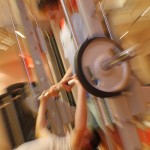 The more you exercise a muscle, the stronger it gets – and that includes the heart muscle. Since over a million people will suffer heart attacks each year, doing things which will make the heart stronger just makes good sense.
The more you exercise a muscle, the stronger it gets – and that includes the heart muscle. Since over a million people will suffer heart attacks each year, doing things which will make the heart stronger just makes good sense.
Why is swimming such good heart exercise?
The cardiovascular aspect. The resting heart rate is about 10 beats per second lower when a person is in the water, and the maximum heart rate will be 10 to 30 beats lower in the water. A swimmer’s heart will pump the same amount of blood as in other exercise, but do it more slowly. While no one completely understands why this happens, it is thought to be due to decreased gravity and the lower temperature of water. This gives swimming an advantage over land exercise, allowing the heart to grow stronger and pump more oxygen to the body. Here are a few resources with more information:
Heart Health and Swimming Pools
Lower risk of heart disease. Swimming burns calories and builds muscles, so a regular regimen of water workouts will boost the metabolism. This will help in managing weight, which will reduce the risk of obesity and heart disease. The American Heart Association states that 30 minutes of aerobic exercise each day lowers the blood pressure, which also reduces the risk of heart disease.
Check with the doctor. Before you begin a swimming routine to improve your heart health, check with the doctor, to make sure she/he clears you to exercise. Ask him how much exercise you should begin with. While the guideline for adults is 30 minutes of moderate intensity exercise, set that as a goal to work for over time – don’t just try to begin at that level.
Start slowly. If you are new to working out, particularly swimming, don’t overdo at first. Swimming is a strenuous form of exercise, so it is suggested that beginners start with 12 to 20 minutes of swimming, and over time, let the length of your swims gradually increase. The best beginning stroke is freestyle.
To get in a great aerobic workout, which strengthens your heart without stressing other body parts, it’s tough to beat swimming. The best bonus – how great you feel after a good swim!
Becky Flanigan writes for AnApplePerDay.com, and her areas of expertise are kids and parenting, exercise and health. She is avid about her workouts, which have ranged from aqua jogging to marathon training. She and her husband Ed also enjoy entertaining, and taking vacations with their 3 kids.
 Subscribe
Subscribe

